
Training facility
The main facility used in this program for lectures and practical exercises is the Japan Coast Guard Academy (Kure City, Hiroshima Prefecture), with its ample history of proven results and experience in developing executive officer candidates of coast guard agencies. There are also field trips to related organizations, field research and practical exercises on actual patrol boats.
Link for the Japan Coast Guard Academy
the Japan Coast Guard Academy |
Lecture room |
Coast guard simulation center |
 |
 |
 |
Participants Profiles
Four officers of coast guard agencies from Indonesia, Malaysia, the Philippines and Vietnam were invited to the training in 2013/2014.Two officers from the Japan Coast Guard were also selected as participants for a total of six to participate in this program.
| Country | Organization | Age | Sex | Rank, title, etc |
|---|---|---|---|---|
| Indonesia | Directorate General of Sea Transportation |
32 | Male | Marine Disaster Response Officer |
| Malaysia | Malaysian Maritime Enforcement Agency |
26 | Male | Investigation Director, Maritime District 10 (Tok Bali) (Lieutenant Maritime) |
| Philippines | Philippines Coast Guard | 33 | Male | Commanding Officer of Special Operations Unit (Lieutenant Junior Grade) |
| Vietnam | Vietnam Coast Guard | 27 | Male | Staff officer, Regional Vietnam Marine Police No. 1 ( Lieutenant) |
| Japan | Japan Coast Guard | 25 | Male | 2nd Navigation Officer of Patrol Vessel (Ensign) |
| 26 | Male | 2nd Engineer Officer of Patrol Vessel (Ensign) |
Program Schedule
The course schedule is as shown below.
| Date | Activity |
|---|---|
| May 14 | |
| May 22 | |
| June 3 to 13 | |
| July 24 to 26 | |
| September 17 to 20 | |
| October 2 to 4 | |
| October 22 to 30 | |
| November 26 | |
| December 18 | |
| December 19 to 22 | |
| February 12 to 16 | |
| February 24 | |
| February 25 | |
| February 28 |
Program Status
February 28, 2014 Overseas participants flew back home
Overseas participants from Indonesia, Malaysia, Philippines and Vietnam departed for their home countries from Narita Airport with a big smile on their face.
Bon voyage!
The mind is already in their home country |
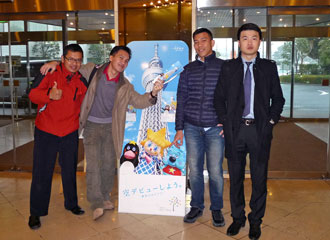 |
February 25, 2014 Participants visited Japan Coast Guard
Six participants made a courtesy visit to Japan Coast Guard after completion of their training. They reported the completion and expressed their deep appreciation to Commandant and executives of JCG.
Commandant made a congratulatory speech on their completion of the 9-month training. He also expressed his hope that the participants will make use of the knowledge and technique they got through the training in their respective countries.
Each participant also reported the result of the training mentioning that they would like to maintain the good relationships built through the training.
The participants were asked about their favorite Japanese food and some overseas participants answered “Yakitori” and “Okonomiyaki” in Japanese. They had a good time as well as good training in Japan.
Participants reporting their result |
Commemorative photo with Commandant and executive officials |
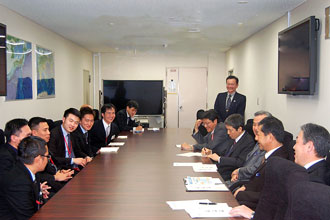 |
 |
February 25, 2014 Participants visited the Nippon Foundation
After the completion of the training, six participants of the Asia Coast Guard Junior Officer Course of Japan visited the Nippon Foundation to report their result to Mr. Unno, Executive Director of the Foundation. Each of them expressed their gratitude to the foundation for the support and also told of their achievements for the last nine months.
Mr. Unno made the following remarks for them with encouragement:
•Play an active role in the international community for the safety and security of the sea of their own countries and also of the Asian region
•Become leaders of their organizations and also good human resource who can contribute to welfare of themselves and others
•Move into action; Determination alone is not enough
•This program has aimed not only to provide the participants with knowledge and experience but also to have all people concerned work together to solve issues. Make the best use of the human network that they have created and keep on utilizing it.
•Looking forward to seeing their bright faces again somewhere in the world
Lastly they took a commemorative photo with Mr. Unno.
Participants reporting their result |
Commemorative photo in the room at the Foundation |
 |
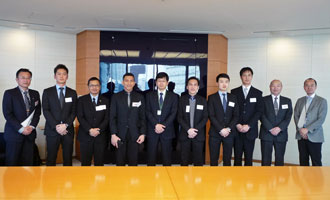 |
February 24, 2014 Completion of the 3rd Asia Coast Guard Junior Officer Course of Japan
At the completion of the 3rd Asia Coast Guard Junior Officer Course of Japan (AJOC), the closing ceremony was held at the Japan Coast Guard Academy.
Superintendent of the Academy presented the certificate and gifts to six participants from Indonesia, Malaysia, Philippines, Vietnam and Japan.
The participant of the Malaysia was also commended by the Superintendent for his outstanding achievement.
The course had started since May 22 and has successfully ended.
Presentation of the certificate and gift |
Presentation of the certificate and gift |
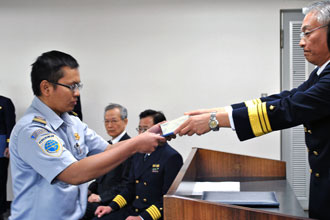 |
 |
Presentation of the certificate and gift |
Presentation of the certificate and gift |
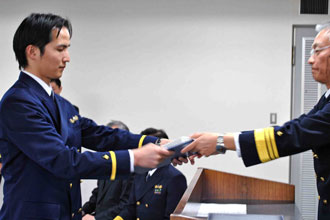 |
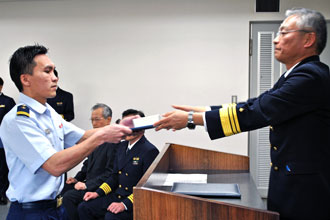 |
Presentation of the certificate and gift |
Presentation of the certificate and gift |
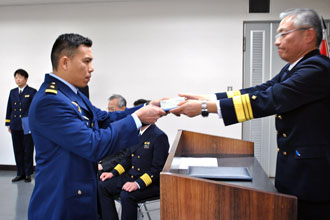 |
 |
Address by the Superintendent |
Commemorative photo |
 |
 |
After the closing ceremony, a farewell party was held. Vice Superintendent delivered a speech. He acknowledged strenuous efforts of the participants and stressed the importance of “kizuna” or bond, and encouraged them for the future.
Speech by Vice Superintendent |
 |
During the party some pictures of the 9-month training were shown on the screen and they looked back on their experiences of life in Japan. Each participant also made a speech expressing their gratitude and also future wishes.
Speech by the participant |
Speech by the participant |
Speech by the participant |
 |
 |
 |
Speech by the participant |
Speech by the participant |
Speech by the participant |
 |
 |
 |
The participants had a good time with those who had become to know in Kure, especially the cadets sharing the experience of the on-board training. They were reluctant to part from them.
Presentation of Japan Coast Guard Foundation Award |
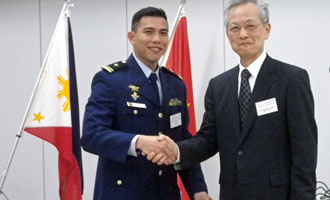 |
Lastly the training advisor made a speech. He expressed his gratitude and respect toward the participants and extended deep gratitude to all concerned.
Speech by training advisor |
Commemorative photo |
 |
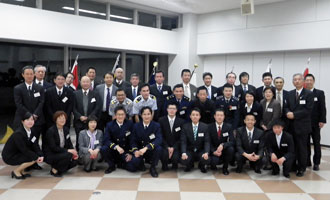 |
this one can be enlarged by clicking on this |
February 24, 2014 Presentation on the study result
All participants presented the results of their study in the class of their training on the final day. Superintendent and instructors of JCGA attended the presentation. The participants had conducted their research on the subjects that they selected respectively with the support of JCGA instructors and the training adviser. There was a lively exchange of questions and answers. They could also receive valuable advice.
Participant presenting his study result |
Participant presenting his study result |
 |
 |
Participant presenting his study result |
Participant presenting his study result |
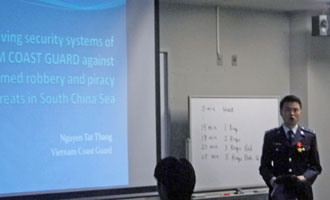 |
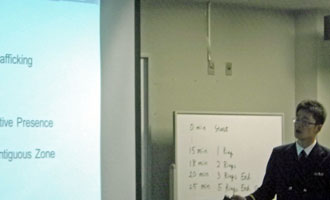 |
Participant presenting his study result |
Participant presenting his study result |
 |
 |
Participant answering questions from the floor |
Exchange of questions and answers |
 |
 |
February 12 to 16, 2014 Hokkaido study trip
Hokkaido is the largest prefecture, and also the second largest island of Japan. In February 2014, we had a trip to come here.
After a long trip from Hiroshima, we truly felt coldness of Hokkaido. On the train to the hotel, we could see full of snow everywhere. It was very beautiful. Then we started walking to the 1st Regional Coast Guard Headquarters. Distance was not far, but it was very cold and slippery.
At the 1st RCG HQ |
Courtesy call on the Commander |
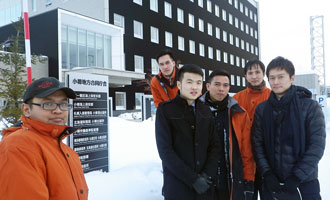 |
 |
We had the courtesy call on the Commander, and then we were briefed about the operations of the1st Regional CG HQ. The weather here is more inclement than other areas, so the work of coast guard officers is also different in many ways comparing to that of other regions and they have ice breakers.
At 7:15am of the following morning, we checked out the hotel and came to JCG Chitose Air Station to fly to Nemuro. I have been flying on Vietnam Coast Guard’s aircraft, but this was the first time for me and all other AJOC participants to fly by JCG’s aircraft. It was a very exciting experience. During the flight we observed not only the work of JCG officers but also the condition of sea ice. Although there were turbulences due to low altitude flight, all of us did not get motion sickness. Everyone enjoyed the flight very much.
Before boarding the craft |
Observing sea ice |
 |
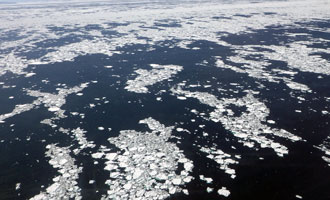 |
Nemuro is still a quite small town and the people live mainly on fishing. However, the view of Nemuro is great, and especially the seafood is very delicious and fresh. It was the first time that I enjoyed whale sashimi.
Next morning, we visited Nemuro coast guard office. We were introduced about the overview of Nemuro coast guard office after paying a courtesy call on the Commander. And then we visited the Cape Nosappu and the Northern Territory Museum, it helped us to understand more about the history and current situation of the sovereignty of islands between Japan and Russia. In the afternoon we embarked one of the newest JCG patrol vessels to observe their routine patrol duty. Nemuro coast guard officers were very kind and friendly. Although the next morning we prepared to leave, they still came to our hotel and took us to visit the frozen lake of Furenko and some natural museum and center. We saw many kinds of bird and eagle.
At the Cape Nosappu |
Observing the islands from the vessel |
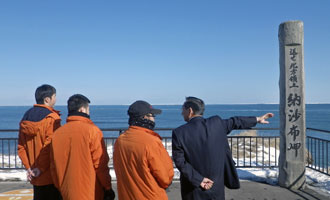 |
 |
December 19 to 22, 2013 KOJIMA onboard training
AJOC participants had the training onboard KOJIMA from 19th to 22nd in December. KOJIMA is a training ship of Japan Coast Guard Academy, whose length is 115 meter and displacement tonnage is 3136 ton, and it is one of the biggest class training ships in the world. It is used for training of the Academy cadets such as a round-the-world trip and the training for domestic navigation etc. About 40 cadets have been trained on this ship. We observed their onboard training and experienced life of training ship with cadets.
Our first impressive thing was “cleaning.” The cadets have to clean up the ship very well and keep the rooms neat and tidy. We understood that keeping ships always clean was a fundamental skill for cadets in order to be always ready as a coast guard officer and we also cleaned up KOJIMA with them.
On the other hand, speaking of pleasure in ship was meals. Meals of KOJIMA were very delicious and it seemed that meals were one of factors to maintain cadets’ motivation.
The cadets were separated to three different courses: Navigation, Engineering and Communication. We observed each course during the voyage and learned what trainings have been conducted. The cadets have been disciplined very well by instructors (officers) of KOJIMA. In each course it is required to communicate well with all members on duty, otherwise it leads to misunderstandings among the members and it may cause any dangerous situations to the ship. In the engineering course, when the cadets checked engines and other machines, they used all five senses and pointed to the parts to be checked by using finger. We learned a lot of measures were taken to avoid mistakes. Moreover, the training of KOJIMA seemed that it was a good opportunity for the cadets to put their knowledge got from lectures in Academy into practice.
At the last day of our onboard training, we observed the towing training. Towing is one of the most dangerous trainings and the all members wrestled with the training more seriously than usual. We were also told that there were many kinds of training in KOJIMA other than towing, for example fire-fighting, search and rescue etc. The cadets had to master not only navigation skills but also such skills to deal with all kinds of accidents.
On the other hand, instructors had big responsibilities and I understood that it was tough work to keep a sense of tense and consider the best way to impart know-how of onboard work to the cadets.
This training was precious experience for us to learn the training system of JCGA. In the midst of internationalization, exchange activities with other countries’ Coast Guard like this training may be one of the necessary programs for Asian counties’ Coast Guard now.
Participants boarding KOJIMA |
Lecture from the Communications Officer |
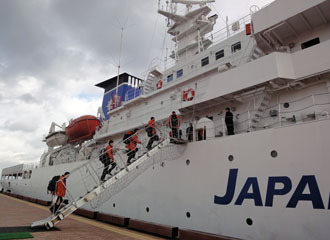 |
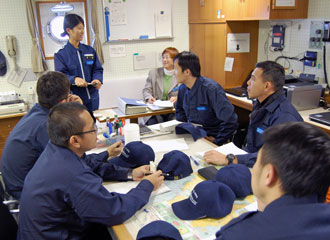 |
Participants working on the chart |
Participants working on the chart |
 |
 |
Speech by representative of the participants |
Commemorative photo |
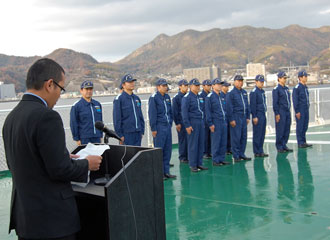 |
 |
December 18, 2013 Moji Coast Guard Office Study Trip
Seven days before Christmas day, AJOC participants had the chance to visit Moji Coast Guard Office located just along the Kanmon Straight of Japan. Kanmon passage is one of the crucial straights where an average of more or less 500 ships traversing from west to east (15 NM) and vice-versa and pass through the Seto inland waters of both foreign and domestic vessels. Obviously it is one of the busiest traffic locations where JCG gives utmost importance to ensure the safe navigation known to at least 5 routes (if vessel transiting westward) along the straight.
Upon arrival, the participants enjoyed the scenic site and drizzling weather where the “Kanmonkyo bridge” can be seen overlooking from the Coast Guard Office. The participants were then received warmly by the Commander himself during the courtesy visit.
After the courtesy visit, the participants proceeded immediately to the lecture room for the briefing and overview led by one of the Deputy Commanders of the CG office in charge of safe navigation department. The lecture gained interest to the AJOC participants because of every detail it provided beginning from systems, current behaviors, rules of the road and lighting systems. It also presented the unique characteristics of the straight and its importance to the maritime industry. The discussion gained further knowledge for the participants after series of related questions were raised by each participant concerning the safe navigation and some maritime issues foresighted.
After the briefing, the participants were escorted to the berthing area to board PC 25 Tomonami for the actual observation of the Kanmon Straight Maritime Traffic. Feeling the excitement, all the participants seated comfortably inside the bridge area while listening to the guide lecturer of one JCG officer as the patrol craft was underway.
The AJOC participants were truly impressed how the maritime system traffic was implemented along the busy straight of Kanmon, because what was presented during the lectures was actually seen and witnessed how exactly it was described. The systematic implementation and installation of all the guidelines are strictly observed as managed properly by the Kanmon MARTIS, Vessel Traffic Service Center. Another impressive point was the application and installation of lighted buoys and lighted markings that provide safe guides to transiting vessels. Such a system requires accuracy and sense of professionalism among JCG personnel to maintain the safe navigation in one of the important straights of Japan.
After the onboard tour, the participants proceeded to the Coast Guard office and bid farewell to the officers and crew of the patrol craft. Truly the trip was such an unforgettable experience for the participants as it was regarded of the exchange programs to learn various systems that Coast Guard capacity should be maintained and developed.
Conducting walkthrough prior Moji |
Lectures onboard PC 25 Tomonami |
 |
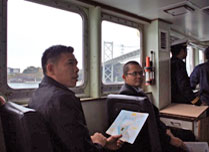 |
Actual observation of Kanmon Straight |
Commemorative photo after the actual tour |
 |
 |
December 6, 2013 Participants interacted with Kendo club members
As part of interaction with JCGA cadets, participants joined the Kendo club practice. They borrowed Kendo uniforms from the cadets and gathered in the Kendo training hall feeling that they somehow became “Samurais.” As they wore the uniforms and stood barefoot holding the bamboo swords, they braced themselves for practice.
At first they learned how to hold and swing the bamboo swords and how to shuffle in a way unique to Kendo. As the cadets put on protective gear for the head and torso, participants made practice swings toward them crying “Men” and “Dou” courageously. Some participants hesitated to hit the female cadet with the sword even though she wore protective gear. After one-hour of hard training some of the participants had blisters on their feet and palms. As they had been looking forward to trying Kendo, they practiced hard and also enjoyed it.
Lastly they observed a practice match between a male and a female cadets who hold a high Kendo rank. The participants were impressed by their neck-and-neck match. Kendo is one of the ancient Japanese ancient martial arts and they could experience it through this practice. Good memories were created and the feeling of the spirit of “Samurai” felt.
Feeling the spirit of “Samurai” |
Learning how to hold the bamboo swords |
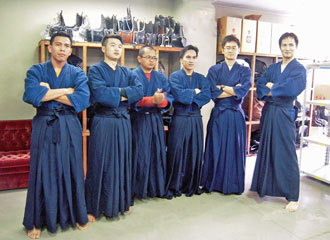 |
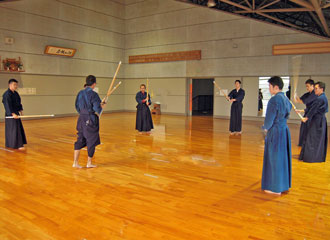 |
“Men” hitting the head of a female cadet |
“Dou”hitting the torso of the opponent |
 |
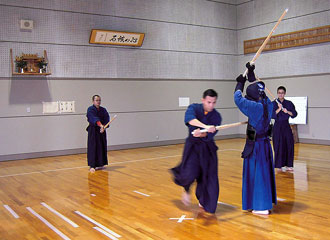 |
Observing practice match between the cadets |
Commemorative group photo |
 |
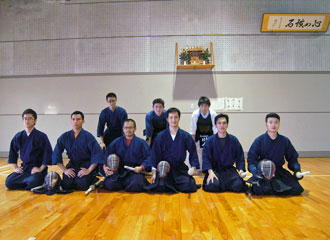 |
November 26, 2013 Kurushima Strait Vessel Traffic Service Center (VTS Center)
Japan has been very popular with the capability to manage and maintain its sea traffic in all of its straits. These capabilities ensure that there is minimum number of ship accident occurred around Japan especially at its congested and most important straits. This will ensure the flow of ship for the purpose of import and export of goods in and out Japan can be maintained and in the meantime ensure very minimal casualties towards the environment.
Kurushima strait bridge |
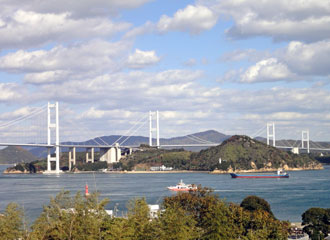 |
Diameter of the cable holding the bridge |
 |
On November 26, 2013 AJOC participants were given a chance to pay a visit and learn about the job and responsibilities of the VTS center manned by JCG staff. They are very lucky that Kurushima Strait VTS center accepted their application to visit and having experience on being in the VTS center themselves. After attending the short lecture, the entire participant was given a tour inside the VTS Center and was well explained about all the system on how it works and most importantly its function to ensure the flow of the traffic goes smooth.
All the participants were amazed not only by the equipment and system equipped there but also by the skills of the JCG staff that play the most important role to ensure the traffic flow is smooth. It is mostly known by all the seafarers that Kurushima Strait has a very unique navigation rule which is “Keep Right in the Traffic Route during Northward current” and Keep Left in the Traffic Route during Southward current.” It is a very tricky navigation rule applied only in Kurushima Strait and also required the outmost attention by the JCG staff to ensure that the flow and safety of the traffic should be well maintained.
Participants experiencing the communication exercise |
Commemorative group photo |
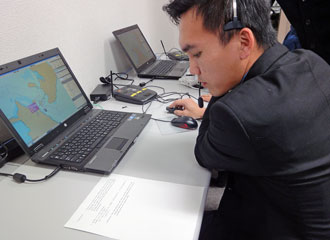 |
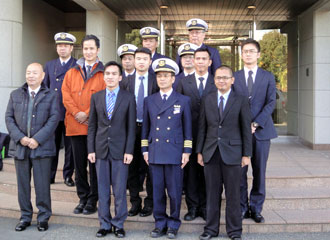 |
Besides oral explanations by the VTS operator on handling the communication equipment between ships and the VTS center, all the AJOC participants were given chances of first-hand experience on operating the communication equipment. This time it was only for the purpose of training though. It seemed that all of them felt it very hard to convey the message or information through radio communication, since it required skills and training on handling the equipment and not to mention the international standards of language used during the communication.
All after all, they were very excited and very satisfied during the study trip. The only words that could be heard out of them were the effectiveness and efficiency of the Kurushima Strait VTS center. They also praised the JCG’s staff for their professionalism, hard work and dedication towards their very challenging job. It seems that they realized the importance of the VTS center for the safety of the traffic flow.
November 27, 2013 Participants interacted with Judo club members
As part of interaction with JCGA cadets, the participants joined the Judo club practice. It was so cold that they hesitated to change into judo uniform; however, they were in high spirits and gathered to meet with the cadets in the judo training hall. Soon after greeting, they started typical judo warm-up.
As they warmed up, they practiced ukemi or breakfall techniques, the basics of judo. Initially they were not good at managing their movement as smoothly as intended. Their motion looked awkward because their bodies were not so flexible. Soon they got the knack of it because they had experienced the arresting technique which has similarities to judo.
They also practiced the offense such as the major outer reap and shoulder throw and repeated them. Lastly they practiced in pairs and had free-style practice. When it came to winning or losing, some of them came out fighting. Some got out of breath fighting in a match.
Nowadays judo is a worldwide sport. The participants could experience it in its home, Japan and it was a memorable time for them.
Warming up carefully |
Practicing ukemi, breakfall techniques |
 |
 |
Practicing a shoulder throw |
Free-style practice |
 |
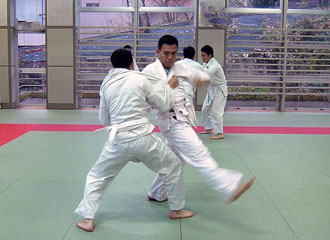 |
Free-style practice |
Commemorative group photo |
 |
 |
November 22, 2013 Participants interacted with baseball club members
As part of interaction with JCGA cadets, the participants joined the baseball club practice. It was a beautiful sunny day after a few cold and windy days. The participants and the cadets came to meet in the baseball field and introduced themselves. They ran two laps of the field and played catch to warm up.
Then they started fielding practice. They skillfully caught and threw the ball. Some of them made a double play. The last part of the practice was batting. Some participants hit the ball very well and some just swung the bat without hitting anything. They had fun practicing. After one hour of the practice they sent hearty cheers to each other and took a commemorative photo.
Self introduction |
Running to warm up |
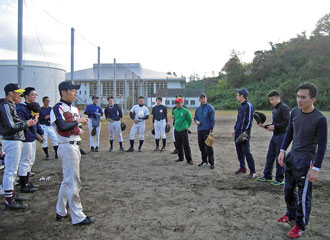 |
 |
Playing catch to warm up |
Fielding practice |
 |
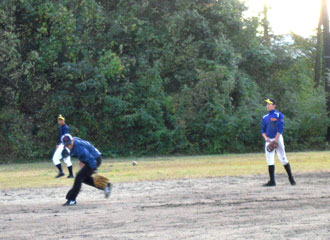 |
Batting practice |
Commemorative group photo |
 |
 |
November 16, 2013 Participants interacted with yacht club members
As part of interaction with JCGA cadets, the participants joined the yacht club practice. Initially it had been planned to try a Snipe class yacht for two persons, however, it got very cold and seawater temperature dropped. Considering the risk in case of capsizing, they decided to take “Sea Princess”, a cruiser for 10 persons.
While some cadets were busy to prepare for departure, the participants gathered in front of the boathouse and were briefed on precautions by other cadets. They put on life jackets and got on the cruiser.
It had rained, but it became sunny before they started. It was a beautiful day with favorable winds. That was perfect weather for cruising. They enjoyed sailing on the Kure bay. As they are men of the sea, the participants got used to the cruiser soon and opened up to the cadets. It’s been a while since they went to the sea. They exposed themselves to salty air and enjoyed cruising on a scenic Kure bay. They had a good time with the cadets through the activity.
Precautions were given |
Sailing on the Kure bay |
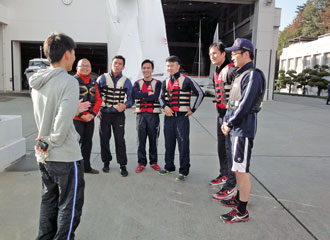 |
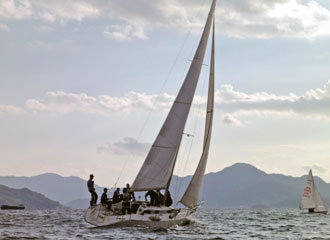 |
Sailing on the Kure bay |
Commemorative photo |
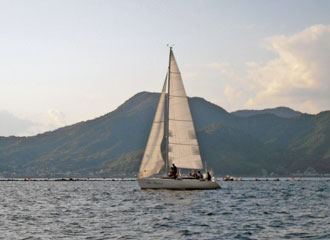 |
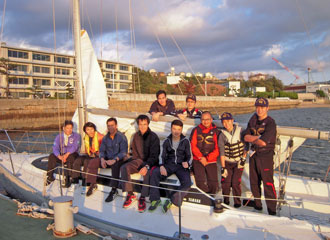 |
November 6, 2013 Participants interacted with rugby club members
As part of interaction with JCGA cadets, the participants joined the rugby club practice. Their ground is nicely located with a view of training ship Kojima alongside the pier and Mt. Furutaka of Etajima over Kure bay.
After they introduced themselves, they did a warm-up carefully in order to avoid getting injured as they raced around in the extensive ground. They did the basics at first such as throwing an oval ball straight applying spin and passing the ball. They ran and ran to practice passing the ball in the ground.
At the end the participants seemed got a bit tired but they had a pleasant sweat working and fatigue. It was a nice exchange activity through playing sport.
Self-introduction |
Warming up |
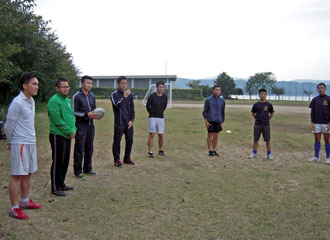 |
 |
Learning how to throw an oval ball |
Practicing passing the ball |
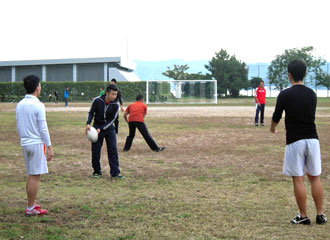 |
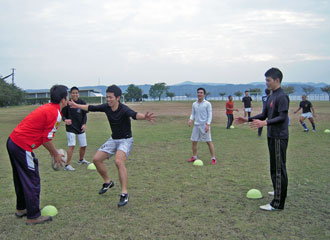 |
Practicing passing the ball while running |
Commemorative photo |
 |
 |
October 28 to 29, 2013 The 2nd week of the Kanto district study trip
Second week of our second study trip to Tokyo started with visiting the JCG Headquarters Operations Center. This was our second trip to JCG HQs. We learned outline of duties of JCG HQs Operations Center, “the brain” of JCG’s operation. It is a centralized operations center which has monitoring, reporting, coordination and command function. This facility gathers all information such as emergency call 118, Global Maritime Distress and Safety System (GMDSS), Ships Security Alert System (SSAS), Japanese Ship Reporting System (JASREP), On-site Video Transmission via satellite, so that JCG will have up-to-date information with regard to maritime accidents and be capable on 24/7 basis of actions together with co-ordination of prompt initial actions by JCG patrol vessels and aircraft. If serious maritime disasters happen, this center will inform it to the Cabinet Offices, Minister and executive members of MLIT without delay, and set up the countermeasures office for comprehensive actions. And they also provide Maritime Safety Information via NAVTEX system.
It took almost one hour for us to travel to Tachikawa City. Tachikawa City is about 40 km west of the center of Tokyo Metropolis, there where JCG Research Center is located. At the Research Center many training topics were prepared, such as:
1. Identification of layers of paint from ship paint flake related to the investigation of maritime incident
2. Identification of drugs, counterfeit bills and passports
3. Recovering electronic data related to the investigation of maritime incident
4. Identification of metal damage/fatigue which causes maritime incident
5. Research on marine pollution and its response equipment
6. Research on navigational aids
7. Research on ships and its equipment using towing tank and wind tunnel
In the metal laboratory |
A colorful Philippine passport under UV light |
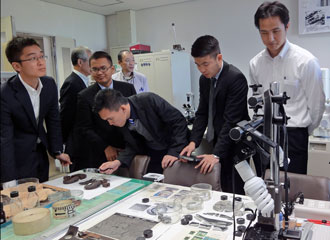 |
 |
Some participants looked into their passport under the UV light to know how to distinguish the original passport from the fake passport, and we found that some of passports have interesting pictures which reveal under UV light. Through this visit, we learned the importance of scientific research and investigation.
Observing the simulation on towing tank |
Group picture with JCG Research Center officers |
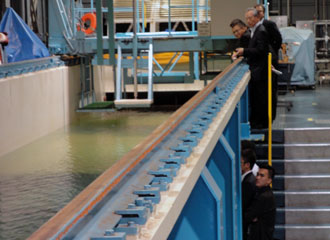 |
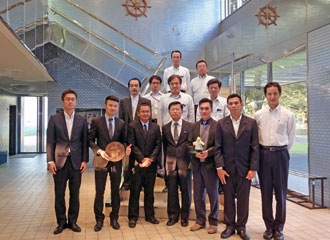 |
In Tuesday morning with misty rain accompany our travel; we went to JCG Hydrographic and Oceanographic Department-JHOD in Odaiba area, a large artificial island in Tokyo Bay across the Rainbow Bridge from central Tokyo. JHOD was established in 1871. Since then, JHOD has been engaged in carrying out various hydrographic surveys and marine observations as well as publishing nautical charts and publications. Outcomes of those surveys and their productions are made available to the mariners through the distributors, internet, etc.
A nautical chart is one of the maritime survey output |
Looking at 3D bathymetric maps using 3D eyeglasses |
 |
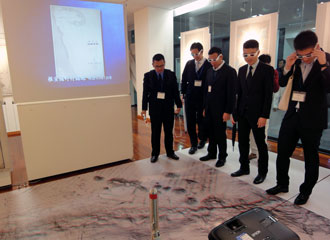 |
The JHOD officer explained and made short tour to the facilities related to the JHOD duties such as:
1. Maritime Safety Information
2. Hydrographic Survey
3. Japan Oceanographic Data Center
4. Oceanographic Observation
5. International Cooperation
6. Survey Vessel and Equipment
One of the purposes of the study trip was to learn the “backbone” system for maritime safety so as to enhance our knowledge on maritime surveys.
Container terminal operations |
Group picture with NYK container terminal managers |
 |
 |
Our last destination was Nippon Yusen Kaisha-NYK container terminal in the Port of Tokyo's Ohi Container Terminal. We visited this container terminal in order to learn about maritime safety, security and environment protection in port operations. We were also informed that NYK conducts several joint exercises with Japan Coast Guard such as Joint Antipiracy Exercise in 2006 and Joint Accident-Response Drill in 2011.
We found that this study trip was very interesting and worthwhile for us.
October 22 to 25, 2013 The 1st week of the Kanto district study trip
It has gotten cooler and the nicest season has come in Tokyo. AJOC participants had a chance to go to the Kanto district for their study trip.
We visited the National Strike Team Station. We received the explanation about oil or hazardous noxious substance, oil spill control and firefighting at sea using actual equipment used by the JCG National Strike Team. The participants were briefly oriented not only of the said Strike Team’s main functions but also of its operations including vessels and aircraft utilization. It deepened our understanding of the meaning of National Strike Team and its importance to JCG in general.
At the National Strike Team Station |
At Yokohama Coast Guard Office |
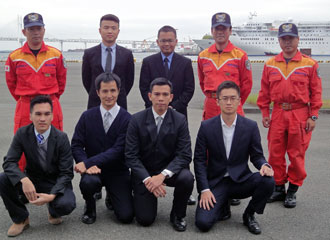 |
 |
In Yokohama Coast Guard Office we observed the diving pool, the shooting training room, the training gym and the disaster preventing facilities. The use and functions of each facility were briefly explained and presented well. Particularly the diving pool facility is unique because it can produce artificial waves, downwash and water currents in order to familiarize the divers and coast guard crew with the real scenarios of rescue operations and emergency procedures. AJOC participants were moved and impressed to know how substantial such type of training can help nurture skilled Japan Coast Guard personnel.
In Japan Coast Guard Museum in Yokohama, the North Korean spy ship which blew herself up off southwest coast of Kyushu in December 2001 was displayed, and the participants showed interest in the large quantity of weapons displayed there.
In front of the spy ship |
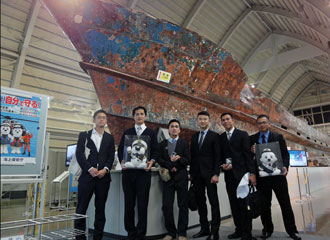 |
In 3rd Regional Headquarters, AJOC participants paid a courtesy call on Mr. Shinjo, Commander of 3rd Regional Headquarters, and received a warm welcome. He mentioned to observe the facilities in this region and learn properly in order to make what we have acquired useful in the future. The participants also had a chance to get onboard the patrol vessel to patrol Uraga suido and Nakanose suido, which are main vessel traffic routes in Tokyo bay. We could see how congested the sea area was and learned the importance of Coast Guard duties there.
In Haneda Air Station, the participants had a chance to observe the latest helicopter acquired by JCG stationed inside the hangar. We were also provided with the latest knowledge on air rescue equipment and its different uses.
In Haneda Special Rescue Station, we also saw the rescue gear specially designed and developed by Special Rescue Team (SRT) members themselves with various functions and uses.
One of participants commented “We should follow their always-improving-spirit. That is, they analyze the matters required from practical operations and try to connect the analysis with next improvements. I believe that the SRT members’ skill must have been also improved by the accumulation since its founding.”
Unfortunately we have had rain on the weekend as a typhoon was approaching. And there was an earthquake of magnitude 3 at midnight. It was awful for the participants who experienced it for the first time but there were no troubles in our first week of Kanto study trip. Others all is well!
October 21, 2013 Special lecture on the Somali pirates
A special lecturer was invited for the AJOC from the UK. Mr. Kiourktsoglou, University of Greenwich, delivered a special lecture to the AJOC participants and the International Affair course of JCGA. The topic was an analysis of the Somali pirates’ business model.
Mr. Kiourktsoglou elaborated the Somali pirates with various statistics and shared his analysis with the audience. The mechanism of the pirates business was explained in detail. Through the lecture the attendee were exposed to new aspects and ideas of the piracy in Somalia.
Detailed explanation with various data |
Questions from the floor |
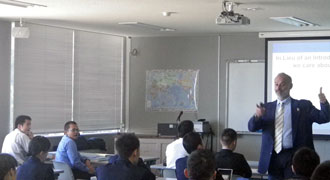 |
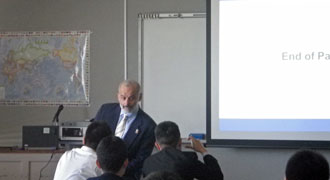 |
Further explanation |
Solutions are . . |
 |
 |
October 18, 2013 Participants interacted with tennis club members
As part of interaction with JCGA cadets, the participants joined the tennis club practice. It was a clear autumn day after a typhoon. They gathered on the tennis court and introduced themselves each other. The cadets did in English and the participants in Japanese creating a friendly atmosphere.
They started practicing. In the beginning some of them had difficulty in stroking and gradually they got the knack of it. Then a cadet and a participant made a team and they played double. In their games some of them played good shots unexpectedly, and that made them surprising and fun.
All in all, it was a good opportunity to get to know each other better. They enjoyed playing tennis and had a good time together.
Introducing themselves |
Warming up |
 |
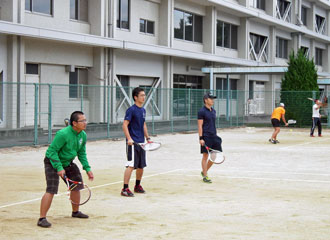 |
Playing double |
Commemorative photo |
 |
 |
October 11, 2013 Participants learned how to identify floating oil
When floating oil is found in the sea area, it is necessary to identify the source of oil. From which ship or facility was the oil discharged? Participants had a lecture and experiment on how to identify the oil.
They learned one of the methods using simple chromatography. Based on instructed procedure, they conducted the experiment using some samples.
Participants confirming the procedure |
During the experiment |
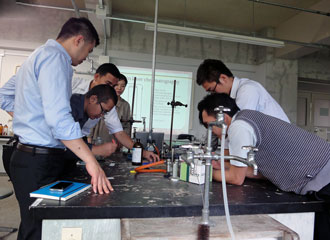 |
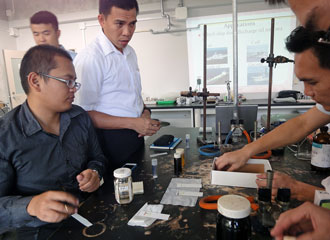 |
Careful work is required |
Waiting for the result |
 |
 |
October 10, 2013 Special lecture by ReCAAP ISC
AJOC participants had a chance to have a special lecture about the Regional Cooperation Agreement on Combating Piracy and Armed Robbery against Ships in Asia (ReCAAP). Two lecturers came from the ReCAAP Information Sharing Centre (ISC) in Singapore.
Commander Matsumura (Japan Coast Guard) gave an overview of the ReCAAP ISC. The participants were briefed on its structure and networking. The activities of the ReCAAP ISC were explained. Importance of information sharing among concerned parties was emphasized as a single country alone can’t eradicate piracies.
Commandant Dogra (Indian Coast Guard) talked about piracies and armed robberies. He updated the participants with trend and characteristics of current piracy cases.
During the Q & A session, they asked a lot of questions and they enjoyed discussing different cases.
Briefed on the ReCAAP ISC |
Lecture and discussion |
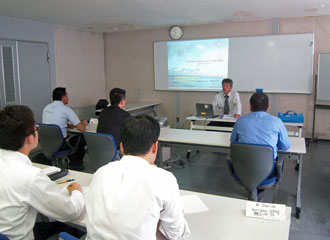 |
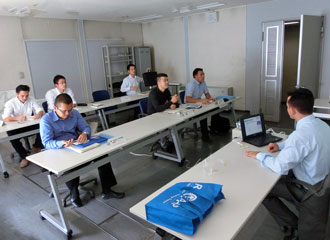 |
Commemorative photo with lecturers |
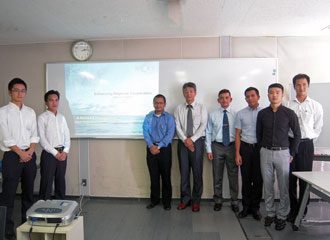 |
Exchange of views during lunch break |
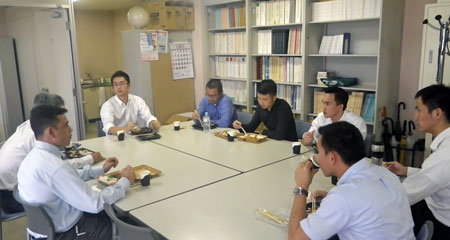 |
October 2 to 4, 2013 Kansai district study trip
We visited Kansai Airport Coast Guard Air Station and Japan Coast Guard School as a study trip from October 2nd to 4th.
Observing the demonstration of the descending |
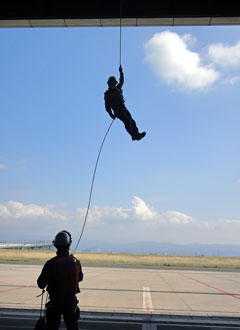 |
Observing a helicopter |
 |
We received an explanation of duties and had a visitation of facilities, especially JCG airplanes and helicopters in Kansai Airport Coast Guard Air Station. This station is different from other offices or stations of JCG at the point of having both of patrol ships and aircraft. In addition to that, there always are mobile rescue technicians in the station, who mainly are engaged in descending from helicopters to save persons in marine accidents.
Kansai International Airport is located on the artificial islands surrounded by sea and it is essential to secure the security and rescue system in order to establish safety of users and smooth use of the airport.
We saw that carrying out their service smoothly by using ships and aircraft together makes big merit for their jobs.
Getting into a cockpit |
Group photo with officials of the Station |
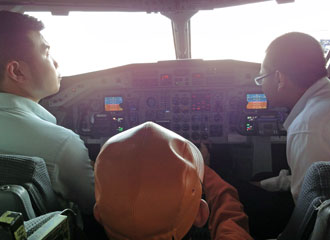 |
 |
Japan Coast Guard School is located in Maizuru city of Kyoto prefecture. We paid a courtesy call on the Superintendent of the school, and after that we received explanation about the school and visited the facilities.
The trainees were working hard at school to get knowledge and skills required to perform their duties as well as mental/physical strength and the spirit of cooperation.
There are 450 trainees there now and its number is increasing. I realized that people’s expectation of the coast guard organization is getting bigger.
At the entrance of Coast Guard School |
Observation in a simulation room |
 |
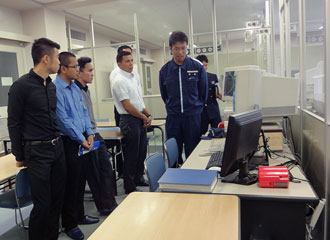 |
Observing the steering room of the training ship Miura |
Explanation about its equipment |
 |
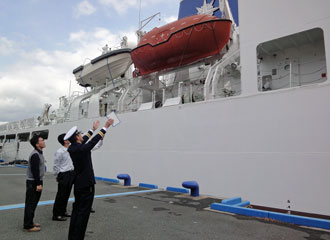 |
We had an opportunity to go to Kyoto that was an ancient capital of Japan before the capital was transferred to Tokyo. We visited Kyoto Imperial Palace called Kyoto Gosyo in Japanese and Nijo Castle.
Kyoto Imperial Palace was built by the order of then the Emperor Kanmu in 794. The building and garden is very elegant and we could see old Japanese cultures.
At the Kyoto Imperial Palace |
At the Nijo castle |
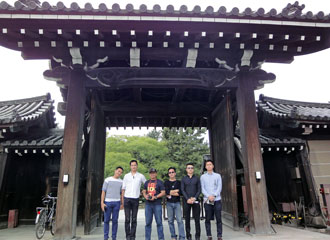 |
 |
Nijo Castle is one of the World Heritages and was built by the order of the first shogun of the Tokugawa shogunate named “Ieyasu.” I thought that the size, arts and appearance of the castle were symbolizing his then power, and we can see the culture of Azuchimomoyama era.
We got knowledge on history of Japan and became interested in Japan more and more.
September 27, 2013 Initial Investigation Training
As part of practical subjects, the training in initial investigation was given. Initial investigation is the basics of criminal investigation. The training was given by a lecturer from the Criminal Affairs Division of the Japan Coast Guard. In the morning lecture he explained the significance and procedure of initial investigation to the participants. In a criminal investigation initial investigation is very important to prove the crime. In the afternoon a mock crime scene was set and the practical training was given by some crew of a patrol vessel of a designated ship for identification, from Hiroshima Coast Guard Office.
In the practice, the procedure was explained one by one such as setting of off-limits area, preservation of the scene, basic photography, bloodstains collection, fingerprints and footprints collection. The participants did them by themselves. Initial investigation is a crucial procedure for elucidation of the crime and its trial, and the investigation requires many precautions in the procedures and its order. The training was very useful for the participants.
Lecturing on initial investigation |
Preservation of the scene |
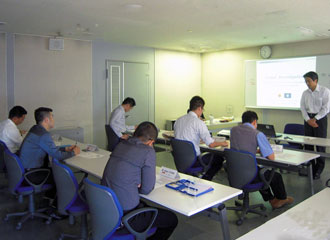 |
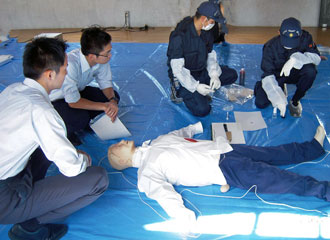 |
Fingerprints collection |
Fingerprints collection |
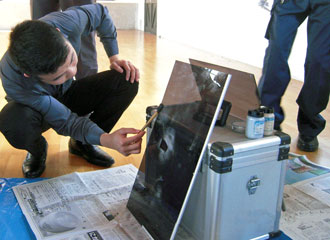 |
 |
Footprints collection |
Commemorative photo with instructors |
 |
 |
September 17 to 20, 2013 AJOC in wonderful island Okinawa
In the third week of September, all AJOC participants had a chance to come to Okinawa. All of us were feeling really excited about Okinawa because it is not only the famous tourist destination which is known by people around the world but also well known about its unique history.
September 17, 11.40 am, the aircraft ANA461 took off and brought us to the island Okinawa leaving Hiroshima.
Upon arrival at Naha airport, we immediately felt different climate compared to Hiroshima. Okinawa was crowded, everyone seemed very happy like they are being in their holiday vacation. The weather here was sunny but the wind was quite strong, so everyone felt cool and comfortable.
Walking to Shurijo castle park |
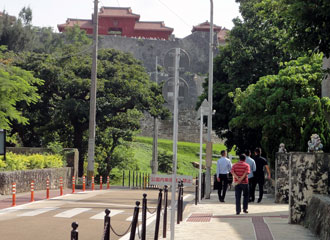 |
Learning history and culture of Okinawa |
 |
After the participants checked-in at the hotel for their baggage, we visited the castle park Shurijo. We could only say anything not more than two words, wonderful and its full of surprises. Everything in Okinawa surprised us. Everything in the castle was very ancient and beautiful. When viewed from above, it had a great view of Okinawa. Although in 1879 the Okinawa became a province of Japan, it still has long history with the Ryukyu Kingdom. The Ryukyu has its own language and customs. The driver taught us one sentence “wonji ipe chura kagi,” it means that “you are so beautiful,” and he said that if we say this to an Okinawan girl, she will give you a kiss.
After a hard day, we went back to the hotel and decided to visit the market of Okinawa. We felt very interesting with seafood and specialties of Okinawa. 1 more special thing we have found was a Vietnamese restaurant inside the market. The restaurant is called "Đảo Nhớ” (small islands). Although we were quite full after a meal, we decided to eat at the restaurant Vietnam. Here we enjoyed some of Vietnamese food. We really like Vietnamese sake “Lùa Mới” (new rice).
Visiting the 11th RCG HQs |
After the intensive session |
 |
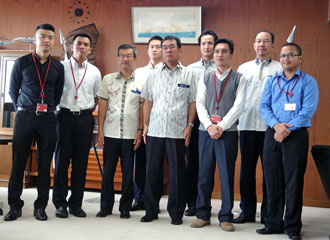 |
On the second day, we visited the 11th Regional Coast Guard Headquarters. Receiving welcome by Deputy Commander of JCG 11th Regional HQs, we were honored and pleased. Although they were very busy, they tried to set up a time to meet and talk with us. Everyone here was very happy with us. Then we were introduced, and learned more about the JCG 11th region, their activities and measures focusing on the national border, remote islands and marine leisure activities. These are really useful. Something we knew, but they would have been applicable in our country.
After a quick lunch on the way, we had a great tour in Okinawa Churaumi Aquarium. We can say that we were all living on the bottom of ocean. Many aquatic animals such as ray (devil-fish), sharks, whales, they're so pretty. We also enjoyed the funny and exciting show of dolphins. This was a very beautiful place.
It was astonishingly beautiful |
Feeling the greatness of aquatic animals |
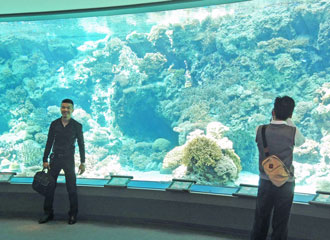 |
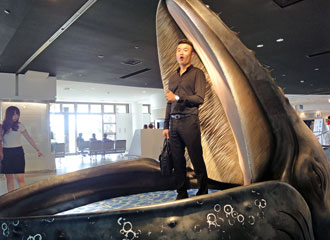 |
The third day was really special and meaningful. We had many pleasant experiences. Firstly, in the morning we were welcomed by Mr. Tamakoshi at Nakagusuku Coast Guard Office. The introduction of the operation and forces here were very rewarding. Not only that, we also observed and interacted with the JCG officers in arrest technique training. We practiced dominating the criminal with handcuff. More specifically, we cruised on a high-speed and agile rubber boat. And the result was that all of us got wet totally. We had to take a shower and change clothes. It was tiring, but immensely rewarding and enjoyable.
In the evening we started coming to the welcome party of JCG officers and leaders of JCG 11th region. The Commander also attended with us. Everyone was very happy and friendly with us. All members of AJOC felt like being in our own country. We talked very much and almost forgot the food.
Practicing the arrest technique |
Hands-on experience on the boat |
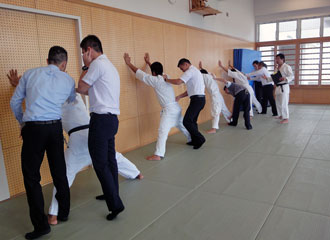 |
 |
The last day was a bit hasty. We visited the JCG Naha Air Station. There was a limited time, for about 2 hours, we learned their roles and functions regarding the remote islands, national border and SAR in wide area. We also learned the spy ship incident and the JCG’s counter-measures.
Learning from the field |
At the Naha station |
 |
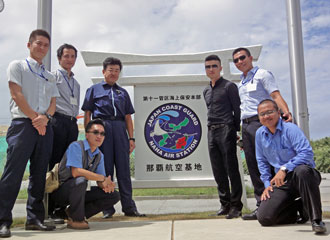 |
The trip was short, but it left many memories and thoughts about Okinawa. This is so beautiful and amazing island. Although our Japanese participants had been here before, all of us said with each other that we definitely would come back Okinawa again.
September 6, 2013 Combustion and explosion experiments
Participants conducted combustion and explosion experiments on Hazardous and Noxious Substances (HNS) as part of marine environment/disaster prevention theory class.
In order to cope with HNS accidents it is important to understand properties of target substances. In this lesson the participants conducted explosion tests to understand lower explosive limits (LEL) and upper explosive limits (UEL) of pentane, hydrogen and acetylene outside the laboratory.
Firstly they found that there were no explosions when the concentrations of those substances were either lower than their LELs or higher than their UELs respectively. Secondly they confirmed that the same tests with different concentrations caused thunderous explosions.
The participants are expected to respond to this kind of HNS accidents in their organizations. Appropriate management of HNS, especially on board a vessel, is crucial because it is enclosed space. They learned how important it is to really understand properties of the substances.
Briefing on the experiments |
Adjusting the concentration of pentane |
 |
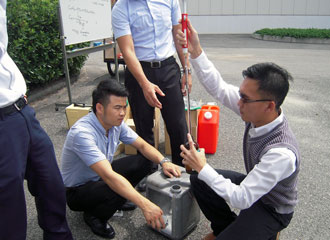 |
Igniting in explosion test with pentane |
Preparing for hydrogen explosion test |
 |
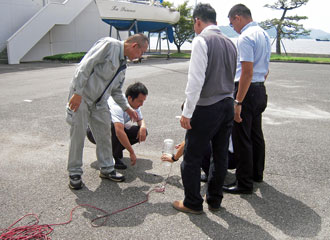 |
Explosion test with acetylene |
After the experiments |
 |
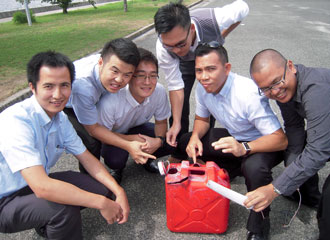 |
July 24 to 26, 2013 The study trip to Kagoshima
We visited Kagoshima. It is located at the most southern part of Kyushu which is a southern island of Japan. We went there to learn about outline of missions provided by the 10th Regional Coast Guard Headquarters and visited Kiire crude oil staging terminal and Sendai Nuclear Power Station.
Before we arrived in Kagoshima we had worried about falling of ashes because Kagoshima prefecture has a beautiful active volcano whose name is “Sakurajima.” But fortunately there were few falling of ashes and that relieved us.
Lecture by Director of Guard & Rescue Dept. |
Tea ceremony was held |
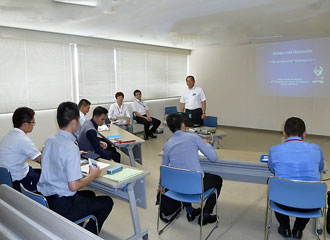 |
 |
In the 10th Regional Coast Guard Headquarters, Commander and the other officials welcomed us very warmly, and they explained their organization and missions and so on.
In this district there are various kinds of missions including international ones and there are lots of remote islands so JCG’s jobs are very important and indispensable here.
After that they held a welcome party for us. They taught us not only their works but also some good cultures of Kagoshima. Some officials held Japanese traditional tea ceremony and performed technics of “Iaido” that is a kind of martial art by using Japanese sword “Katana.” At the end of the party we danced a traditional dance in Kagoshima called “Ohara-odori.” We received a warm reception and had a pleasant time with them.
Master of “Iaido” |
commemorative photo with the master |
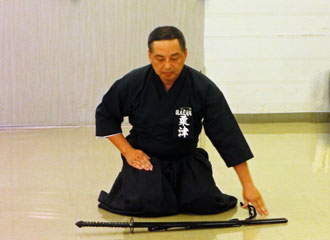 |
 |
Warm and friendly welcome |
|
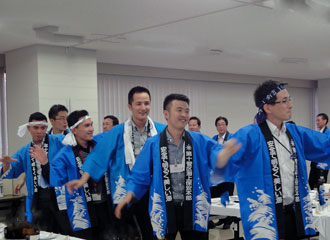 |
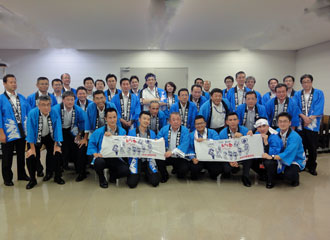 |
We visited Kiire crude oil staging terminal which is a stock yard of oil and a world-class transshipment and storage terminal. We observed their facilities, crude oil tanks, and equipment and learned about maintenance to ensure safety. They have some equipment to take measures against some accidents like a fire or oil spill. The size of the tanks and other facilities surprised us. We also observed the system to ensure safety. It was also large and that has been well established.
Observing a tanker at the terminal |
Observing various equipment |
 |
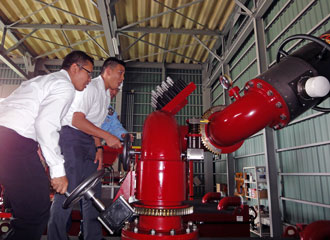 |
On the last day of this visitation, we observed Sendai Nuclear Power Station. They have two reactors but both of them have been shut down. We could see some equipment to take measures against some accidents, for example earthquakes and Tsunami and so on, at this station, too. Some measures were taken under the influence of the accident of Fukushima Nuclear power plant.
Commemorative group photo |
 |
In this trip we were able to see that safety measures are taken at each facility as well as that missions to maintain security are provided by the 10th Regional CG Headquarters.
We got a good stimulus to consider the coast guard system, its duty and what is necessary for our duty.
July 10, 2013 Participants interacted with swimming club members
As part of interaction with JCGA cadets, the participants joined the swimming club practice.
They put on their swimsuits and gathered at the poolside.
Before starting exercise, both the participants and the swimming club members introduced themselves. They warmed up sufficiently and went into the water.
After they finished the usual training of the club, they were divided into three groups and had a relay race.
It has been a long time since they really swam in the pool. Although they looked a little tired around the end of the exercise, they swam vigorously under the temperature of over 35 degree Celsius.
gathering at the poolside |
warm-up |
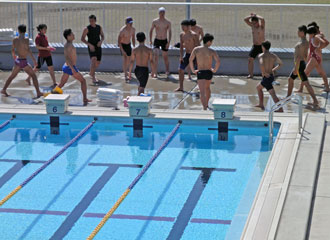 |
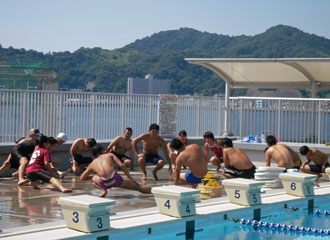 |
swimming swiftly |
relay race |
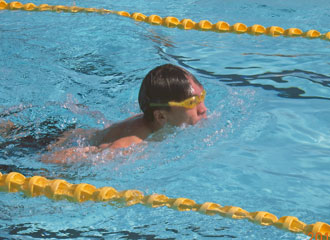 |
 |
July 5, 2013 Participants interacted with cutter club members
As part of interaction with JCGA cadets, the participants joined the cutter club practice.
Before starting exercise, both the participants and the cutter club members introduced themselves. After warming up sufficiently, they boarded the cutter and took their respective positions.
They had difficulty in using the oar and sometimes failed to row in the beginning, as they had not been used to doing that. However, the participants are young coast guard officers. They soon got the knack of it and rowed the cutter together with all their strength.
Around the end of the exercise, their oars moved in harmony with each other and the cutter ran lightly on the sea in front of JCGA.
warm-up |
oars moving in harmony with each other |
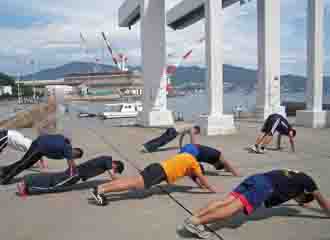 |
 |
This one can be enlarged by clicking on the picture |
running lightly |
commemorative group photo |
 |
 |
June 27 to 28, 2013 International Cadet Conference
On 27th-28th June 2013, the International Cadet Conference was held at JCGA. This conference is organized once a year inviting other coast guard cadets to various exchange activities. This year, 2 participants from the Canadian Coast Guard College and the Korea Maritime University respectively attended the conference. AJOC participants were also invited.
Presentation by each organization |
Discussion by panelists |
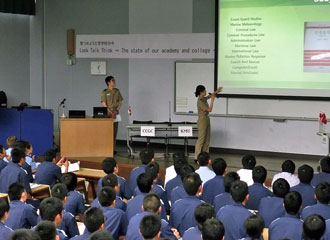 |
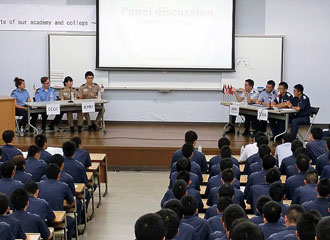 |
The International Conference consisted of three parts: presentation, panel discussion and group discussion. The theme of this conference was to present and discuss various activities of the cadets in their dormitory.
During the presentation they introduced their organizations concerning the theme. It was amusing to see how different the culture and atmosphere of every country was.
Panel discussion was then held, and AJOC representatives shared their insights about the topics.
After the panel discussion, the third part was the small-group discussion and it was the first attempt in the conference. All the cadets including AJOC participants discussed the meaning of dormitory life.
In this period every cadet had a chance to ask and convey their ideas about the topic. At first it took a while for the discussion to go smoothly because not all of the cadets could express themselves fluently in English. However, the following day I observed that all exchanged their opinions with each other and language barrier never seemed to be a problem until the closing program.
Group discussion |
Commemorative photo |
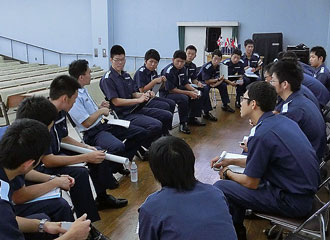 |
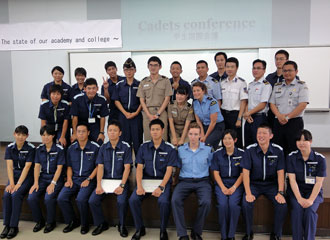 |
Various opinions were argued in the conference and, the chairperson, who was also a JCGA’s cadet, closed the program by saying the following points;
We were born in different countries and studied at different academy or university and so there may be different culture or customs. However, we can aim at the same goal and mission and we are no different each other. We are here to train and study to maintain and sustain peace, safety at sea and marine environment. This international conference is a starting point and I hope that this good relationship will continue until the end.
I think that his words are true as we study the maritime environment. Now we talk about the system of each organization and discuss the issues that each organization is facing. We are also making effort to utilize this AJOC program through specialized and high-level training regarding coast guard operation. Participating in this conference once again reminded me of the purpose of this program, such as helping foster my understanding of other participants, as well as developing cooperation and mutual trust among the agencies of each country.
The international exchange program including the cadets’ conference was held from June 25 to July 1 at the Japan Coast Guard Academy (JCGA). We invited four cadets from the Canadian Coast Guard College and the Korea Maritime University (one male and one female cadet from each).
We also invited Asia Coast Guard Junior Officer Course of Japan (AJOC) participants to the program. At the cadets’ conference, they attended presentations about the organization of education and training for coast guard missions and cultures of each country. They actively exchanged opinions based on their work experience with other participants. AJOC participants also joined other programs such as the special lecture and experiences of Japanese culture with the invited overseas cadets. Through the international exchange program, I believe that we could enhance our mutual understanding and will build good relationships among the coast guard organizations in the future.
Experiencing Japanese culture |
Playing the koto, Japanese harp |
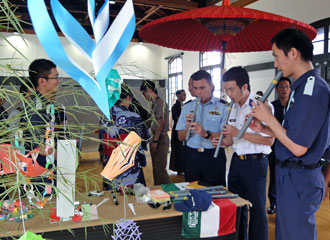 |
 |
June 21, 2013 GREAT TIME OF AJOC IN ARREST TECHNIQUE CLASS
When we came back from Tokyo, all of us felt exhausted, but we had a good weekend; we cut the hair, washed the clothes, played sport,…and we felt refreshed, ready for a new week in JCGA.
This week we had many interesting lectures and subjects such as: maritime traffic, vessel facilities, HNS, Coast Guard laws and policy. And there was one subject that made all of us be in a fluttering and exciting experience. That was the physical exercise of arrest technique class.
The first class was given on Monday afternoon. Although every one of us had our own technique, we were very interested in the technique of JCG. Before the class started, our Japanese participants showed us the formality of the technique class, for example bowing before entering in the doorway, bowing toward the teacher. We tried to become real JCG cadets. At first we had to take a warm-up exercise led by one of the participants in a common way and Mr. Goto in JCG’s way. It was very strange and hard. We knew that, our teacher, Mr. Goto was a strict teacher, but he was always smiling and trying to teach us the technique carefully.
Participants stretching to warm up |
Carefully warming up |
 |
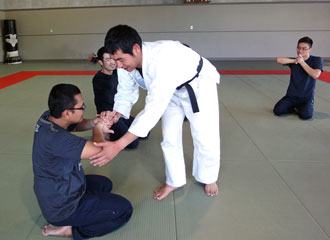 |
After the warm-up we began the real arresting technique. That was great; we learned many surprising and interesting techniques. Such as: locking and unlocking the hand, how to escape from the enemy. Some of us felt hard and painful but we really liked it. I myself think that it’s very good and useful in line of work. When we finished the class, all of us felt a little bit tired but we were very happy and it was really fun.
Practicing the technique |
Learning by doing |
 |
 |
The second class was on Friday afternoon. At first we continued learning and practicing the new arresting technique with Mr. Goto. Most of us could do the technique much better and easier than the 1st time. Especially we were very surprised when Mr. Goto showed us the way to escape when the enemy tries to oppress us ruthlessly. It was very easy, but all of us didn’t know until we learned it.
After break time we had a chance to practice and exchange with members of the arresting technique club. We met many young male and female cadets and they were very nice, funny, and professional in kung-fu. We practiced the kung fu and martial arts with each other. After talking and exchanging the experience and technique, we found all the club members very cute and friendly. But what a pity! The time was so short and we had to say goodbye to them. We hope that we can practice again together with each other.
Practicing with the club members |
Commemorative photo |
 |
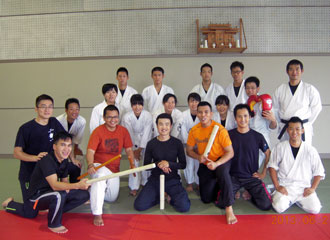 |
There were only two classes of arresting technique but all of us felt very happy and satisfied with no doubt. We think that the arresting technique class is very essential and helpful for us. It will help us develop more knowledge and capacity in real job.
In conclusion, I and three participants want to say “thank you very much” to Mr. Goto, the Arresting Technique Club and JCGA who helped us having a great time with arresting technique exercises and activities.
June 19, 2013 Participants observed a patrol vessel Okitsu
Participants were given a chance to visit and see a patrol vessel Okitsu. The vessel has been sent from Shimizu Coast Guard Office to the Japan Coast Guard Academy for supporting the training for divers of JCG.
Okitsu is a new patrol vessel commissioned in June 2011. It is a high-speed and sophisticated patrol vessel equipped with the 20mm cannon and infrared search and monitoring device. The vessel is boarded by Umizaru or divers and is operated for search and rescue and lifesaving as a specified rescue vessel at the sea of Shizuoka prefecture mainly in Suruga Bay and the Enshu Sea.
After briefed by Chief Communications Officer, the participants visited inside the vessel. They found that the layout of bridge and etc. were well arranged in order to enhance prompt and smooth operations as it was a state-of-the-art patrol vessel.
It was the first time for them to observe a patrol vessel. A lot of questions about its performance came out showing their great interests toward the JCG’s latest patrol vessel.
Briefing by Chief Communications Officer |
Wheelhouse of Okitsu |
 |
 |
Explanation about diving gears |
Observing the stern of the vessel |
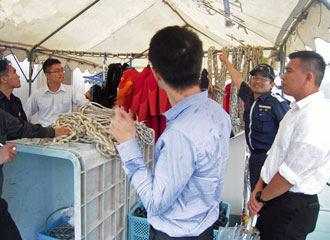 |
 |
June 13, 2013 Participants visited the Nippon Foundation
Participants paid a courtesy call on Mr. Unno, Executive Director of the Nippon Foundation on their last day in Tokyo.
At first the participants introduced themselves in English using some Japanese. They expressed their gratitude for having the opportunity to join the training and also their ambitions.
Mr. Unno gave them following remarks:
- People are proud of what they decide by themselves rather than what is given by others. The opportunity of the 9-month training is given to you, however, please be aware that you are always choosing whatever offered to you under this environment while obtaining knowledge and experiences.
- We hope that the knowledge and experience you gain through this training in Japan will become the base of what you achieve in the future.
Then a participant from the Philippine stated that they got very interesting challenge for the training. He mentioned that he would strive not only for the improvement of his organization but also for the betterment of humanity.
Lastly Mr. Unno encouraged them to tell that making the most of the opportunity depends on the participants themselves.
Courtesy visit to Mr. Unno, Executive Director |
Participants introducing themselves |
 |
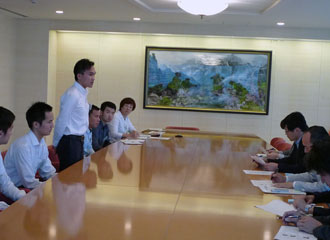 |
Commemorative photo |
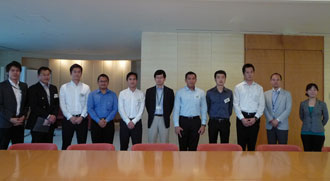 |
This photo can be enlarged by clicking |
June 10 to 13, 2013 The 2nd week of the Tokyo study trip
We were continuing our class/lecture at JCG HQs with our fresh mind, after having great time exploring Tokyo on weekend.
On the eighth day in Tokyo, the lecture continued with the topic of the JCG’s Maritime Traffic Safety and the JCG’s Guarding at Sea system. We learned how JCG is controlling the traffic on Japan waters and how to utilize maritime traffic control system for guarding Japan waters.
On the ninth day, lecture was about Crisis Management and Transnational Crimes. Both of these subjects attracted attention from Japanese participants and Malaysian participant, because they had real field experience on those topics.
On the tenth day, which was the last day of lecture, Indonesian and Philipino participants were very interested in the lecture about the JCG’s Marine Environment and Disaster Management system because it’s related to their daily works.
The participants had a very interactive and applicative lecture by means of a table top exercise on how to manage large scale disaster at sea and the corresponding response strategy.
We also got lecture from Capt.Tokunaga on Organization Management, from Sun Tzu’s “the Art of War” to Maslow theory, he compiled much knowledge on management especially on Organization Management and conveyed his thoughts on organization management, he also gave us support and encouragement to learn from this course and contribute to the strengthening of peace, security, co-operation among countries.
Not only study on the coast guard on class, we also learn the culture of each country, and one way is introducing our authentic food from each country.
After Japanese and Philippine, now it’s time for some Indonesian food. Thankfully, some friends from Indonesia who worked in Tokyo (Mr. Popik Montanasyah and Mr. Wahyu Ardhiyanto) invited the participants to have dinner at the Indonesian restaurant at Odaiba area in Tokyo. Lumpia, Martabak, Sate, Rendang, Kari are some of the food we tasted. They had a great time chatting, laughing and learned Indonesian cuisine and food culture. Many thanks for both of them.
Cultural exchange over Indonesian cuisine |
 |
And the last day in Tokyo, the participants went to the Nippon Foundation to make a courtesy call on Executive Director Mr. Unno. The participants received a very warm welcome, and a very encouraging remark from him. Many expectations were addressed to the participants but he emphasized that it is up to the students on how they determine to take advantage of this opportunity to make themselves and their country proud. On that occasion, the participants promised that they would study hard and make use of the knowledge for enhancing their capacity and capability and also their cooperation.
At noon we all went back to the HIP in Saijo using Shinkansen. On our way back I was looking forward to seeing Mount Fuji that we missed out on the first trip using the Shinkansen, but unfortunately the sky was cloudy, so we missed the chance to see it again. But I hope that one day I could see Mount Fuji directly, or even climb it.
Safely arrived at Higashi hiroshima |
 |
Only two week in Tokyo, our first study trip, but we brought much knowledge and unforgettable experience, thanks to the JCG official and staff who made a lot effort to make this visit worth for us.
June 3 to 9, 2013 The 1st week of the Tokyo study trip
Departing from Hiroshima International Plaza already made the AJOC participant get nervous. Knowing that they will go to Tokyo but not knowing anything about Tokyo life made them even more nervous.
Participants accompanied by their coordinator boarded shinkansen Bullet Train from Higashi-hiroshima and had to transfer to another shinkansen before arriving Tokyo. 5 hours of travel time made them all exhausted but excitement was seen in their faces since this was the first time for them to be in Tokyo. 2.00 pm local time, they arrived at their residence in Tokyo which was Hotel Asia Center of Japan. Considering the packed schedule, participant didn’t have time to rest since they had to learn how to board train and which train to board for JCG’s headquarters. It only takes 30 minutes from their hotel to JCG’s headquarters but they had to walk for around 5 minutes and board 2 trains to get there.
Arriving at JCG’s headquarters, a warm welcome and short briefing was given by Captain Eguchi before the meeting with JCG Commandant. Sharp at 3.00 pm the participants were warmly welcomed by JCG Commandant who was accompanied by both vice commandant and 3 other high rank personnel from JCG’s headquarters. All the participants were given a very encouraging speech by the commandant. Then all participants briefly introduced themselves and pledged to take this program seriously to enhance their skills and knowledge for their own organization’s future and the future of Asian sea water territorial safety.
On the second day in Tokyo, lecture was about Theory of leadership, International Cooperation and Public Relation. All the participants got involved intuitively during the lecture. At the end of the lecture, all the participants gained new knowledge on how to be a good leader, importance of International Cooperation and also were impressed to know the fact that Public Relation was also very important for the future of organization. Excitements of the day did not end there since there was a welcoming party. They had a good time with Director of Education and Training Division Captain Tokunaga, JCG’s headquarters staff and all other guests.
Vice Commandant for Operations lecturing about the leadership |
Director for International Cooperation lecturing with active discussion |
 |
 |
On the third day, a Vietnamese participant was very interested in the lecture about the JCG’s Intelligence system. An Indonesian participant and one of Japanese participants were, however, interested more in the lecture about Oceanographic and Hydrographic Operations. In the lecture on Human resource management, all participants seemed to attain new knowledge on handling their subordinates.
On the fourth day, lecture was about the JCG’s Information and Communication Technology (ICT) system and Maritime Criminal Investigation. Both of these subjects attracted attention from the other Japanese participant and a Malaysian participant.
On the fifth day, lecture continued with the topic of the JCG’s ICT system and the JCG’s Search and Rescue system which attracted great attention from a Filipino participant.
Participant expressing his opinion |
Practical demonstration to carry a survivor |
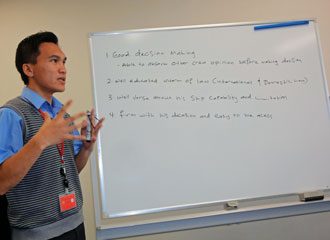 |
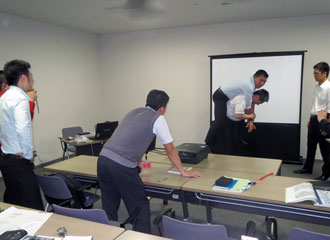 |
Weekend was long awaited by the participants. They were having very good time exploring and visiting interesting places in Tokyo. They visited the Tokyo Sky tree which is one of the tallest towers in the world. Waking up early in the morning didn’t bother them because of their excitement. After that, they visited Asakusa, Shibuya town, Ginza town, Tokyo Palace, and Akihabara Town. These enhanced more trust between them which is one of the purposes of the AJOC training.
June 12, 2013 Participants took a table-top exercise of marine disaster prevention
Participants were given a table-top exercise by the staff of Marine Environment Protection and Disaster Prevention Division using the case study of a large scale marine disaster occurred in Tokyo Bay about 40 years ago.
The exercise went on the assumption that an LPG tanker (50,000GT) and a cargo ship (10,000GT) collide in Tokyo Bay causing a big fire. The participants were given instructions to prepare a plan to perform the following duties:
a. To put/fix wires to both ships
b. To pull a ship away from the other
c. To put out fire on both ships
d. To rescue crew
e. To notify ships in the area and the residents about the dangerous situation
The participants were provided with the chart of Tokyo Bay and discussed how to do the duties. Then the participant from Indonesia presented their response measures. After his presentation the lecturer pointed out that their methods to put wires and to notify the nearby residents were not enough.
Assuming that the situation gets worse, the tanker drifts toward land occasionally exploding. The participants located the point to have her grounded in Tokyo Bay.
The lecturer instructed them to consider the heavy traffic in the Bay
Lastly the lecturer explained that this incident of 40 years ago had led to some developments for preventive measures. For example: a new act, organizational reinforcement such as special rescue team, firefighting ship, gears and equipment.
Participants mentioned that they had experienced to coordinate marine rescue operations in the field, however, they had never experienced a large scale incident like this before. They learned a lot from this case study.
During the exercise, Director of Marine Environment Protection and Disaster Prevention Division visited the class to observe them and he stated that he was impressed by their enthusiasm about the exercise.
Explanation was given |
Participants discussing response plan |
 |
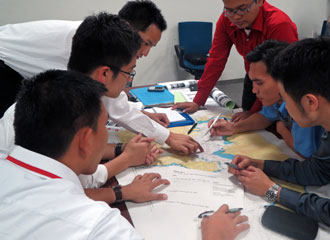 |
Participants discussing response plan |
Participant presenting their plan |
 |
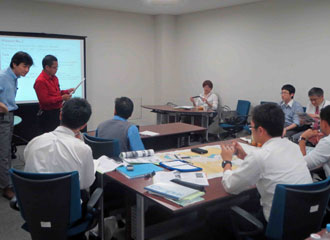 |
The lecture commenting on the plan |
Director observing the exercise |

| 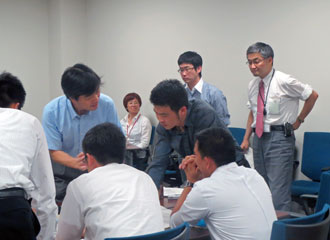
|
June 7, 2013 Participants had a lecture on search and rescue mission
As part of introduction to coast guard missions, the lecture on search and rescue was given by the staff of JCG Search and Rescue Division.
At first the participants were briefed about outline of search and rescue mission including current situation of marine accidents and marine search and rescue operations. The marine search and rescue operations are classified into self saving, mutual saving and public saving. Explanation was given about each activity and also about how the JCG responds.
Then the search and rescue system of the JCG was introduced. Under the system rescue divers, mobile rescue technicians, and special rescue team have their respective activities. The participants were explained about them in detail watching some slides, pictures and video footage.
Lastly the lecturer talked about Japan Disaster Relief team. JCG personnel sometimes join the members of JDR.
The participants asked questions about the procedure to send the rescue team such as special rescue team after the marine disaster: how to search the missing on the sea: how to search drift oil at night: how to determine the search area by airplane etc.
At the end of the lecture, the lecturer demonstrated how to carry a survivor on one’s back as they had watched that in the video. He also mentioned the precautions.
Lecture on search and rescue mission |
Lecture on search and rescue mission |
 |
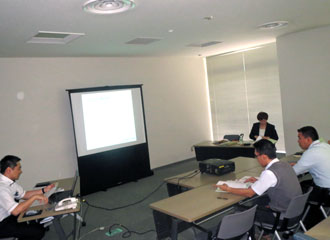 |
Practical demonstration to carry a survivor |
 |
June 4, 2013 The intensive lectures on the coast guard missions have started
An intensive course on the coast guard missions has started at the Japan Coast Guard Headquarters.
The main objective of this Tokyo study tour is to grasp the general picture of coast guard missions and to learn the basics of each mission through this course.
In the first class, they were lectured about the leadership by Vice Admiral Sato, JCG Vice Commandant for Operations.
When they were asked how a commanding officer should be, they answered “good decision making after absorbing other crew’s opinion,” “the heart and brain of the vessel,” and role model.” The lecturer was impressed by their answers.
They had a lecture on the JCG organization and missions by Captain Eguchi, Director for International Cooperation in the next class.
The lecture proceeded with active discussion on how the coast guard should be. This was a good opportunity for them to reflect more on their respective organizations and their missions.
This intensive course continues until June 12. The participants will be briefed about the following missions from the JCG Headquarters officials.
- Maritime crime regulatory missions
- Security measures against international crimes and pirates
- Security missions
- Search and rescue missions
- Marine environment protection and disaster prevention missions
- Marine traffic safety missions
- Info-communication missions
- Coast Guard organizational and operational administration, leadership
Vice Commandant for Operations lecturing about the leadership |
Director for International Cooperation lecturing with active discussion |
 |
 |
June 3, 2013 Participants made a courtesy visit to Japan Coast Guard
At the beginning of the Tokyo study trip, participants paid a courtesy call on the Japan Coast Guard Headquarters and got a warm welcome from JCG Commandant Admiral Kitamura and other top officials.
In the meeting, Admiral Kitamura offered words of encouragement to the participants as follows:
- It is said that the center of the world economy is shifting from western arena to eastern arena, from northern arena to southern arena of the globe. That means all of the participants’ countries are located in the pivot states of the world economic center. In order for countries to economically develop, it is essential to secure stable ocean environment. The ocean is a lifeline of the countries. As the ocean is borderless, it is essential for neighbor countries to make good relationships and work together. From that perspective, it is a precious opportunity for future leaders of coast guard organizations to get together and develop network and friendship through this training.
- For the coming months, the participants will learn about JCG activities.As not all of information that they will get are directly applicable in their country situation, they are expected to process the information in their mind, select whatever applicable in their countries, and take advantage of them to improve their respective organizations.
- While the participants will stay in Japan until the end of next February, they are also expected to have a lot of experience of not only working but also playing, and learn about Japanese culture and society.
- I sincerely hope that this training program will be fruitful and successful.
At last the participant from Indonesia presented a gift to Commandant.
Visiting JCG Headquarters |
Commandant giving encouragement |
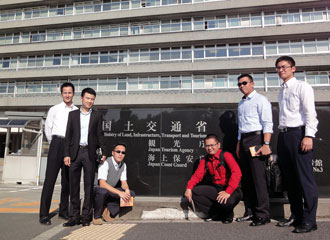 |
 |
Participants introducing themselves |
A participant presenting a gift |
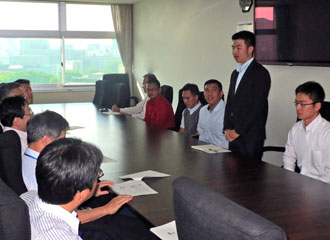 |
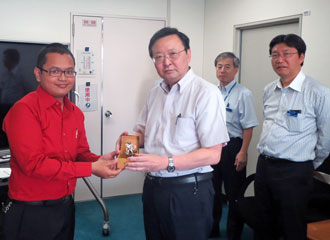 |
Commemorative photo with executives |
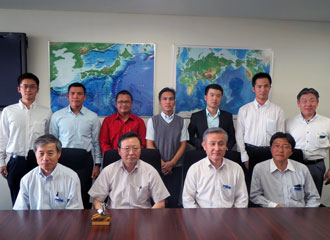 |
This photo can be enlrged by clicking on |
May 30, 2013 Participants observed the diving training
Participants observed the diving training implemented by the Japan Coast Guard Academy.
This is to train divers of the Japan Coast Guard. 14 elite trainees selected from all over Japan take part in the training. This diving training was featured in the box-office hit movie “Umizaru” and on-location shoots were done here in Kure.
At first AJOC participants observed the training at the poolside. Then they went down to see inside through the observation window located on the side of the swimming pool. In the training trainees were placed in a situation in which they were tangled in nets and ropes at 5 meters deep and their respirators were removed. The trainees needed to escape from such obstructions by working with their buddies.
After the observation, all the participants mentioned that the training was extremely tough and they felt choked just looking at it.
Overview at the poolside |
Observing the break-away training |
 |
 |
Working with his buddy to escape |
 |
May 29, 2013 Participants played basketball with cadets
As part of interaction with JCGA cadets, the participants joined the basketball club practice.
Both the participants and the basketball club members gathered in the gym. The club members introduced themselves to the participants in English, and the participants did the same but with a little of their freshly learnt Japanese. This was good for breaking the ice.
All of them were divided into two groups and had a practice game. The game was heated and tough. As the participants are fit and strong young officers of coast guards, they played neck and neck with the younger and fast-moving club members. The 20-minute game drained them dry of energy. After the sweaty session, they cheered each other and took a commemorative group photo with big smiles.
Self-introduction in both languages |
Practice game |
 |
 |
Heated game |
Commemorative group photo |
 |
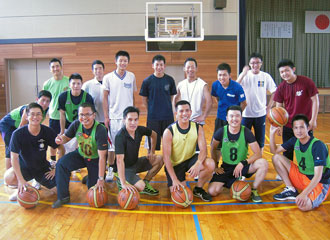 |
May 24, 2013 Participants played soccer with cadets
As part of interaction with JCGA cadets, the participants joined the soccer club practice.
Both the participants and the soccer club members gathered in the soccer ground and they introduced themselves to each other in a friendly way. One of the members gave brief instructions on what to do on the day and everyone carefully warmed up. They were divided into two groups and had a practice game.
In the beginning the participants played hesitantly, but gradually warmed to the game. It was a very hot day, but the participants from hot countries actively ran around in the large ground. They enjoyed interacting with the cadets in an exciting, although sweaty, game.
In their sportswear |
A short meeting before practice |
 |
 |
At first, warming up |
Practice game |
 |
 |
May 27, 2013 Participants observed the inspection of issued goods
Participants had a chance to observe how the inspection is conducted at the Japan Coast Guard Academy. The inspection is conducted twice a year in order to check the storage condition and any loss of goods issued to the cadets from the academy, such as uniforms and bedclothes.
The cadets placed the goods in defined order on their beds in their dormitory, and declared one by one to instructors with an uptight look.
It was a useful opportunity for the participants to observe and compare the inspection method as most of the participants had similar experiences during their education and training period in their own countries.
Word of command for the inspection |
Participants observing the inspection |
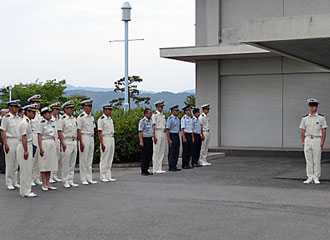 |
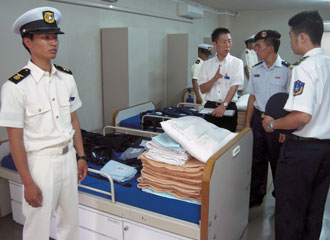 |
May 23, 2013 Country and job reports were presented
On the next day of the opening ceremony, the participants presented the situation of maritime safety and security of their respective countries at the first session of their training.
The presentation, which Superintendant and staff of Academy also listened to, was done with a very active question-and-answer session.
Participant from the Philippines presenting his report |
Participant from Indonesia presenting his report |
 |
 |
Participant from Japan presenting his report |
Participant from Japan presenting his report |
 |
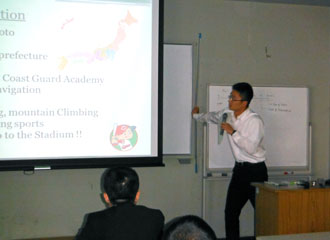 |
Participant from Vietnam presenting his report |
Participant from Malaysia presenting his report |
 |
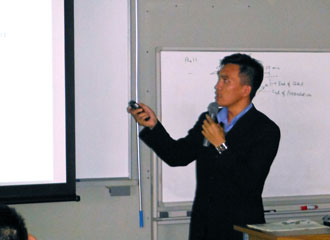 |
May 22, 2013 The opening ceremony was held
The opening ceremony of the 3rd Asia Coast Guard Junior Officer Course of Japan was conducted at the Japan Coast Guard Academy. Six participants from Indonesia, Malaysia, the Philippines, Vietnam and Japan attend the course.
Admiral Majima, Superintendent of Japan Coast Guard Academy, gave instructions to the participants that they are expected to complete the studies successfully and achieve the great results with confidence.
After the address of welcome by Mr. Amaya, Director General of the Administration Department of Japan Coast Guard, and Mr. Ishibashi, President of the Japan Coast Guard Foundation, the participant from Malaysia made a pledge to improve their knowledge, to deepen mutual understanding and to build good relationships among the participants.
Superintendent giving instructions |
Director General of Administration Dept. giving a welcome address |
 |
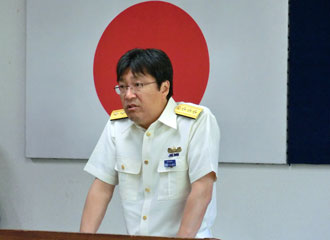 |
President of the Japan Coast Guard Foundation |
The participant from Malaysia making a pledge |
 |
 |
Commemorative group photo |
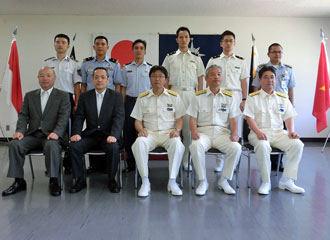 |
Before the opening ceremony, the ceremony designed to introduce the participants of AJOC to the cadets of JCGA was conducted.
The participant introduced themselves and received a hearty welcome from the representative of cadets at the ceremony.
Participants introducing themselves |
Representative of the cadets giving words of warm welcome |
 |
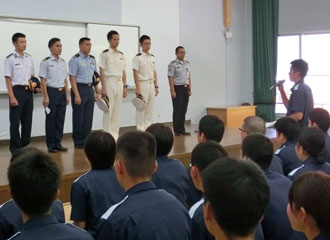 |
After the opening ceremony, the participants got aboard the training boat “Itsumori” and cruised Kure Bay, the sea in front of the Japan Coast Guard Academy.
Participants on the training boat |
Passing the narrow strait “Ondo no Seto” |
 |
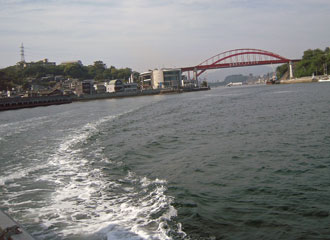 |
In the evening, the welcome reception was held. They had a good time with Director General of Administration Dept., JCG, Superintendent, the Academy staff, cadets and other guests.
Vice-Superintendent giving an welcome address |
Participants giving a self-introduction |
 |
 |
Having a pleasant talk |
Having a pleasant talk |
 |
 |
Having a pleasant talk |
Having a pleasant talk |
 |
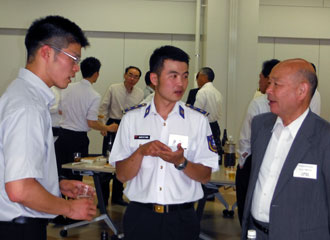 |
Commemorative group photo |
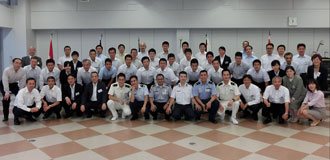 |
this one can be enlarged by clicking on this |
May 15, 2013 Orientation
The participants were given the orientation to understand the program at Hiroshima International Plaza. They were explained about the purpose and contents of the training.
They also looked around the facilities under the guide of the staff of Hiroshima International Center.
Explanation of the purpose of the training |
Explanation of the contents of the training |
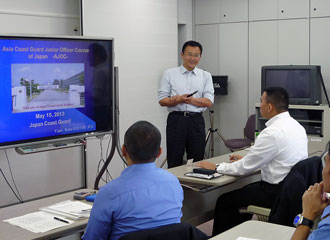 |
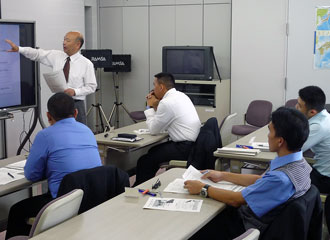 |
Observing the gymnasium |
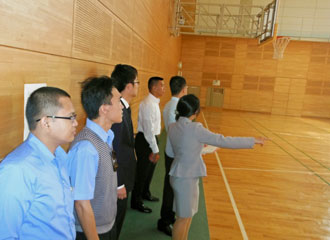 |
May 14, 2013 Overseas participants arrived in Japan
Four overseas participants, invited from Indonesia, Malaysia, the Philippines, and Vietnam, arrived in Japan.
They will be given an orientation at Hiroshima International Plaza, their residence, until the training will start on 22 May.
from the Philippines (at Narita International Airport) |
from Vietnam (at Narita International Airport) |
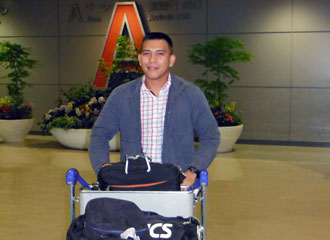 |
 |
from Malaysia (at Narita International Airport) |
from Indonesia (at Narita International Airport) |
 |
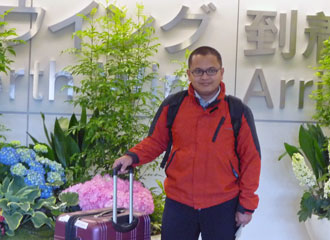 |
Arrived at the final port (Hiroshima Airport) |
 |
May 8, 2013 Participants of the 3rd AJOC were decided.
Six participants of the 3rd AJOC were decided.
Four officers of coast guard agencies from Indonesia, Malaysia, the Philippines and Vietnam and two from Japan Coast Guard will join the training in 2013/2014.
Overseas participants will arrive in Japan on May 14 and have an orientation for five days. Two Japanese participants arrived at Japan Coast Guard Academy in Kure earlier than the overseas participants. They are helping the preparation of the program so that the program begins smoothly. They are also making and practicing their country reports presentation, as all of the participants will introduce their coast guard organizations and duties each other at the beginning of the training.
—from Japanese participants—
Satoshi
Hello. I’m Satoshi Yamamoto. I’m glad to participate in this program.
I’ll do my best to broaden my thought regarding coast guard system. And I would like to establish good relationships with other members.
We are looking forward to arrival of the other countries’ participants.
Yudai
I look forward to their arrival so that everyone gathers, and the program starts.
During the short period for nine months, let's do our best so that it will be a wonderful experience.
At the entrance |
Preparing their presentation |
 |
 |













